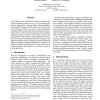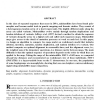309 search results - page 47 / 62 » Contextual alignment of biological sequences |
BMCBI
2005
13 years 7 months ago
2005
Background: Popular methods to reconstruct molecular phylogenies are based on multiple sequence alignments, in which addition or removal of data may change the resulting tree topo...
COMAD
2009
13 years 5 months ago
2009
The continuous and rapid advent in mobile and communications technology opens the way for new research areas and new applications. Moving Object Databases(MODs) are among the emer...
RECOMB
2002
Springer
14 years 8 months ago
2002
Springer
In the class of repeated sequences that occur in DNA, minisatellites have been found polymorphic and became useful tools in genetic mapping and forensic studies. They consist of a...
RECOMB
2006
Springer
14 years 8 months ago
2006
Springer
Homology identification is the first step for many genomic studies. Current methods, based on sequence comparison, can result in a substantial number of mis-assignments due to the ...
BMCBI
2006
13 years 7 months ago
2006
Background: Non-coding RNAs (ncRNAs) have a multitude of roles in the cell, many of which remain to be discovered. However, it is difficult to detect novel ncRNAs in biochemical s...


